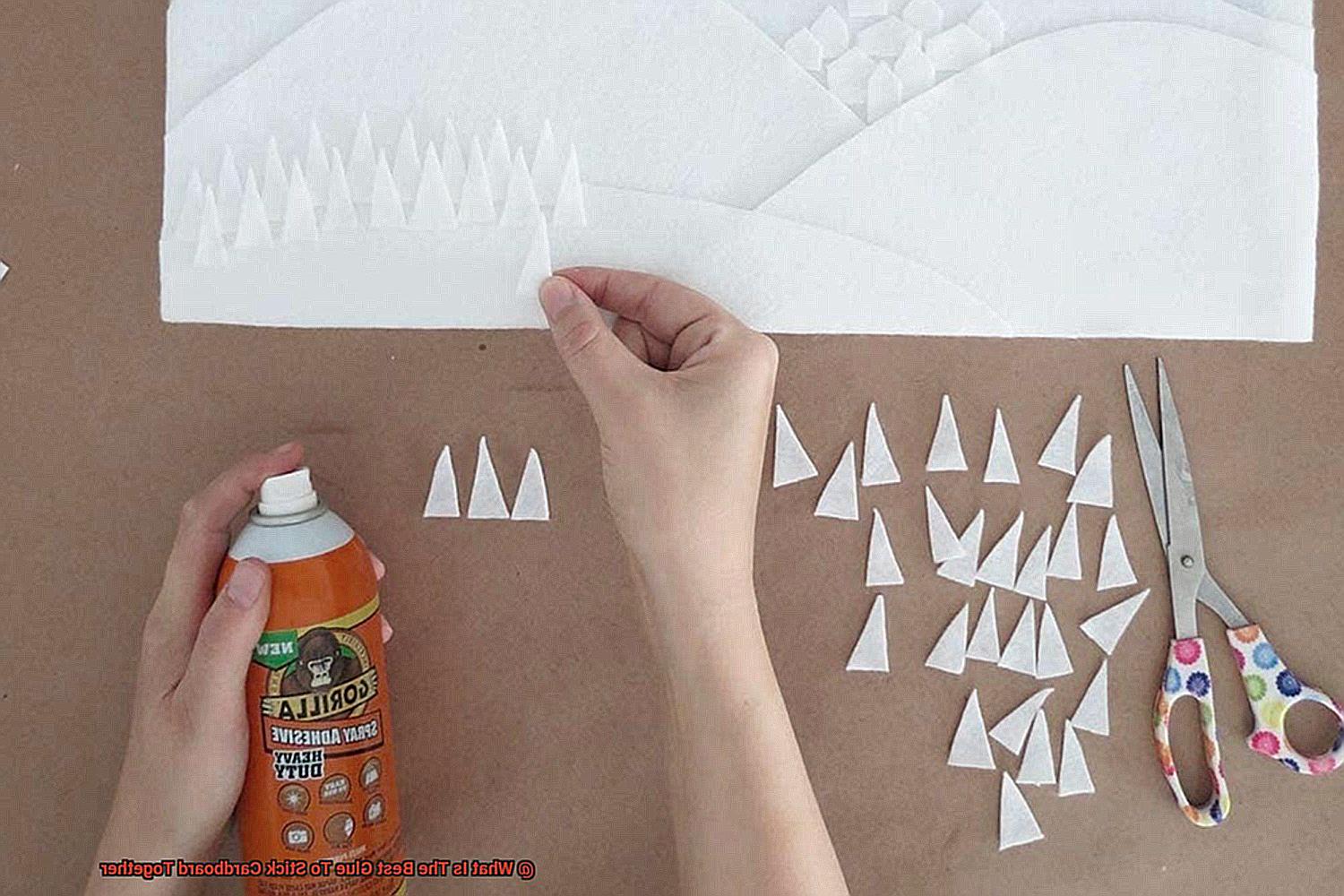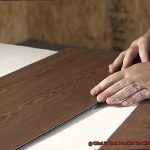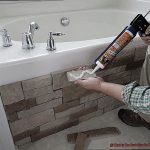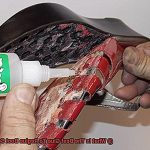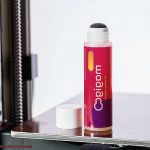Do your cardboard creations crumble like a house of cards?
Are you tired of painstakingly crafting intricate designs only to have them unravel at the slightest touch? Well, fret no more because we’ve got the ultimate solution for you.
In this blog post, we’ll be delving into the world of adhesive magic and uncovering the holy grail of glues that will keep your cardboard projects rock solid. Whether you’re a DIY enthusiast or a student with a penchant for impressive school projects, finding the perfect glue is key to ensuring your creations withstand the test of time.
So grab hold of your beloved cardboard masterpieces and prepare to witness an adhesive revolution that will leave flimsy crafts in the dust. It’s time to say goodbye to disappointment and hello to sturdy, awe-inspiring cardboard wonders.
Let’s dive right in.
Types of Glue for Cardboard
Contents
- 1 Types of Glue for Cardboard
- 2 Factors to Consider When Choosing the Best Glue for Cardboard
- 3 Pros and Cons of White Glue
- 4 Pros and Cons of Hot Glue
- 5 Pros and Cons of Epoxy Adhesive
- 6 Pros and Cons of Specialized Glues
- 7 Different Types of Cardboards Require Different Glues
- 8 Conclusion
Choosing the right glue is crucial for ensuring a strong and long-lasting bond. In this article, we will explore the different types of glues for bonding cardboard, analyzing their pros and cons. So, let’s dive in and discover the perfect glue for your next cardboard masterpiece.
White Glue
Also known as school glue or craft glue, white glue has become a go-to choice for crafters of all ages due to its versatility, affordability, and user-friendly nature. So let’s dive deeper into the topic and uncover the advantages and limitations of using white glue on cardboard.
Advantages:
- Versatility: White glue is a true chameleon when it comes to bonding materials. It effortlessly adheres cardboard to various surfaces, making it the perfect adhesive for all your crafting projects. Whether you’re creating models, decorations, or prototypes, white glue has got you covered.
- Affordability: We all love a good deal, right? Well, white glue won’t break the bank. Its budget-friendly price allows you to stock up on this adhesive without emptying your wallet. So you can indulge in your creative endeavors without worrying about the cost.
- Easy Cleanup: Oops. Spilled some glue? No worries. White glue is water-based, which means you can simply grab a damp cloth or sponge and wipe away any excess adhesive. It’s like magic. No more sticky messes to deal with.
- Safe for All Ages: White glue is non-toxic, making it safe for children to use under adult supervision. So why not involve the whole family in your creative adventures? With white glue, everyone can join in the fun without any worries.
- Packaging Options: Whether you need a small container for a quick project or a larger bottle for more extensive creations, white glue comes in various sizes and packaging options to suit your needs. You can choose what works best for you and your specific project requirements.
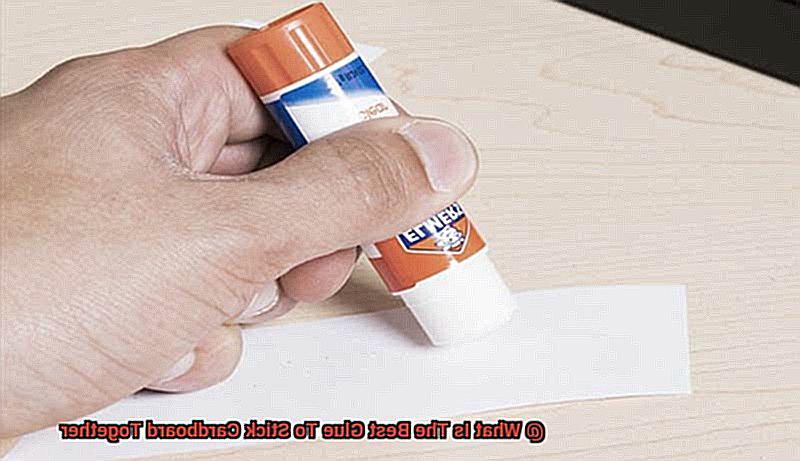
Limitations:
- Strength of Bond: While white glue is effective for most cardboard projects, it may not provide the strongest bond compared to specialized adhesives designed specifically for bonding cardboard. If you’re working on heavy-duty applications or projects exposed to moisture or extreme temperatures, it’s worth exploring alternative glues for a stronger and more durable bond.
- Drying Time: Patience is key when using white glue on cardboard. It requires at least 24 hours to dry completely, so resist the urge to touch or move your glued pieces until they’re fully set. This can be a bit frustrating if you’re eager to see your finished masterpiece, but trust the process and wait for that perfect bond.
Despite its limitations, white glue remains a popular choice for gluing cardboard due to its versatility, affordability, and easy cleanup. It provides a strong enough bond for most crafting projects and offers a user-friendly experience for both beginners and seasoned crafters alike. So grab your favorite crafting materials, unleash your creativity, and let white glue work its adhesive magic on your next cardboard masterpiece.
Hot Glue
Hot glue is a versatile adhesive that is widely used for sticking cardboard together. Its quick drying time, strong bond, and flexibility make it a go-to choice for crafters, DIY enthusiasts, and even in industrial applications.
One of the standout advantages of hot glue is its rapid drying time. Unlike other glues that can take hours or even days to fully cure, hot glue solidifies within seconds or minutes. This means you can assemble your cardboard projects swiftly, saving you valuable time and allowing you to move on to the next step without delay.
In addition to its speedy drying, hot glue forms a strong bond once it cools down. This reliable connection ensures that your cardboard creations will stay intact, even under moderate stress and pressure. Whether you’re constructing intricate structures or adding embellishments to your projects, hot glue has got you covered.
Moreover, hot glue is incredibly versatile. It adheres well to various types of cardboard, including corrugated, chipboard, and regular cardboard. Furthermore, it can bond cardboard to other materials such as fabric, plastic, or wood. This opens up a world of possibilities for your creative endeavors, allowing you to mix different materials and create unique and eye-catching projects.
Applying hot glue on cardboard is a breeze too. All you need is a trusty hot glue gun to melt the glue sticks, and then you can apply it directly onto your desired areas. The precision and control you have over the amount and placement of the glue make it easy to achieve the perfect bond.
However, it’s important to exercise caution when working with hot glue. The high temperature can cause burns if mishandled, so be sure to take necessary safety precautions. Additionally, while hot glue provides a strong bond for most applications, it may not be suitable for heavy-duty projects or those exposed to extreme conditions. Always consider the specific requirements of your project and choose the best adhesive accordingly.
Epoxy Adhesive
When it comes to finding the perfect glue for bonding cardboard, look no further than epoxy adhesive. This two-part wonder is a true superhero in the world of adhesives, offering a multitude of benefits that make it the ultimate choice for sticking cardboard together. In this comprehensive guide, we will delve into the top reasons why epoxy adhesive should be your go-to glue of choice.
Unmatched Bonding Strength:
Epoxy adhesive is renowned for its incredible bonding strength. Unlike other glues, it forms a robust and durable bond that can withstand heavy loads, pulling forces, and tearing. With epoxy adhesive, flimsy projects are a thing of the past, and you can create masterpieces that stand the test of time.
Resistance to Moisture and Temperature Extremes:
One of the most remarkable features of epoxy adhesive is its resistance to moisture and temperature extremes. Once cured, it becomes waterproof, making it ideal for outdoor installations or projects that may come into contact with water. Additionally, epoxy adhesive remains unaffected by high temperatures, ensuring that it won’t lose its bonding properties even in extreme heat conditions.
Gap-Filling Properties:
Bonding uneven or textured cardboard surfaces can be a challenge, but fear not. Epoxy adhesive comes to the rescue with its excellent gap-filling properties. It effortlessly fills in gaps and irregularities, resulting in a smooth and even bond across the entire surface. No matter how uneven or challenging the cardboard surface may be, epoxy adhesive conforms to its shape, creating a sturdy bond that lasts.
Versatility:
Epoxy adhesive is not limited to just bonding cardboard; its versatility extends to various materials such as metal, wood, plastic, and more. Whether you’re working on DIY projects, repairing household items, or engaging in intricate craftwork, epoxy adhesive is your go-to glue for virtually any bonding need.
Specialized Glues
Crafting with cardboard is a boundless avenue for creativity, where your imagination can take flight without breaking the bank. But, as any experienced crafter knows, choosing the right glue is paramount to ensure the success of your project. In this captivating blog post, we will delve into the enchanting realm of specialized glues designed exclusively for bonding cardboard. So, prepare to embark on a journey of sticky wonders as we unravel the secrets that lie within these magical adhesives.
Cardboard Glue:
Let’s begin our adventure with a glue that is tailor-made for cardboard. This remarkable adhesive boasts a unique formulation, carefully crafted to bond seamlessly with the porous surface of cardboard. With its exceptional bonding strength and moisture resistance, it stands strong even in the face of humid conditions.
PVA Glue:
Enter the versatile and budget-friendly hero of crafters everywhere – Polyvinyl acetate (PVA) glue. This beloved adhesive forms an unbreakable bond with cardboard while drying clear and being water-based for easy cleanup. A reliable companion for a multitude of DIY projects involving our beloved cardboard medium.
Hot Glue:
Now, prepare to wield the power of heat with hot glue guns, an essential tool in every crafter’s arsenal. These fiery adhesives work their magic on cardboard too. Offering speedy setting times and creating bonds that are as unyielding as they are swift. However, be cautious when using hot glue on projects that may face temperature changes, as they can weaken its grip.
Epoxy Resin:
For those seeking unparalleled strength and unwavering durability, look no further than the majestic epoxy resin. This mystical adhesive combines a resin and hardener to create a bond that defies time itself. Ideal for projects that demand the utmost fortitude, but be sure to heed the instructions closely for proper mixing and curing.
Spray Adhesive:
When faced with vast cardboard surfaces yearning for a quick and uniform embrace, spray adhesives emerge as the heroes of convenience. These enchanting aerosol cans deliver a seamless coat of adhesive, perfect for lightweight applications. While they may not possess the same strength as their specialized counterparts, they serve as a tremendous option for certain cardboard endeavors.
Contact Cement:
Behold the superhero adhesive that conquers even the most challenging materials, including our beloved cardboard – contact cement. This potent glue demands application on both surfaces, drying until it reaches the pinnacle of tackiness before uniting them in an unbreakable bond. A force to be reckoned with, its strength and flexibility are unparalleled, but beware its potent odor and ensure proper ventilation.
Factors to Consider When Choosing the Best Glue for Cardboard
First and foremost, let’s talk about bond strength. When selecting a glue for your cardboard projects, you need one that will create a strong and durable bond. Imagine building a cardboard house that collapses at the slightest touch – not ideal. Look for glues specifically formulated for bonding cardboard, ensuring that your creations stay firmly together even under stress or pressure.
Now, let’s discuss drying time. Depending on your project and deadlines, you’ll want to choose a glue that suits your time constraints. Some glues dry quickly, allowing you to move on with your project swiftly. Others take longer to dry, giving you more time to position and adjust the cardboard pieces before the bond sets. It’s all about finding the perfect balance between speed and flexibility.
Next up is the application method. Different glues come with different applicators – squeeze bottles, brush applicators, or spray bottles. Consider the size and type of your project when choosing the application method. For intricate designs or small pieces of cardboard, glues with brush applicators may be more suitable. On the other hand, spray bottles are ideal for larger surfaces, providing even coverage with ease.
Toxicity is another important factor to consider. Some glues emit strong odors or fumes due to harmful chemicals present in their composition. If you’re working in an enclosed area or with children, it’s wise to opt for non-toxic or low-odor glues. This ensures a safe working environment without compromising on bonding strength.
Flexibility is key when it comes to bonding cardboard. We all know that cardboard is a flexible material, prone to bending and movement. That’s why it’s crucial to choose a glue that can withstand these shifts without cracking or breaking apart. A flexible glue will keep your projects intact, even when they’re subjected to minor vibrations or twists.
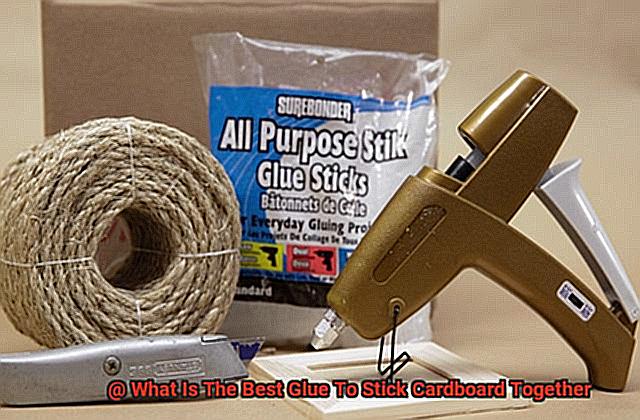
Water resistance is another consideration, depending on your project’s requirements. If your cardboard will be exposed to moisture or damp environments, it’s essential to choose a glue that offers water resistance. This prevents the bond from weakening or disintegrating when in contact with water, ensuring the longevity of your project, whether it’s an outdoor sign or a storage box.
Ease of use is a factor that shouldn’t be overlooked. Some glues require specific techniques or tools for application, making them more suitable for experienced users. However, if you’re new to working with cardboard or have limited adhesive experience, fear not. There are user-friendly glues available that can be easily applied by anyone, providing clear instructions for a hassle-free bonding process.
Pros and Cons of White Glue

White glue, also known as PVA glue (polyvinyl acetate), is a crafting staple that has stood the test of time. But before you embark on your next cardboard creation, let’s dive into the pros and cons of using this versatile adhesive.
Pros:
- Strong bonding capability: White glue forms a durable bond that can withstand moderate stress and handling. Whether you’re working on a simple craft or constructing a structural masterpiece, white glue has got you covered.
- Ease of use: With its liquid form, white glue is a breeze to apply. Use a brush or nozzle applicator to spread it evenly, and watch as it dries clear, leaving your project with a clean and professional finish.
- Non-toxic and safe for children: The non-toxic nature of white glue makes it a popular choice for educational projects or crafts involving young ones. You can have peace of mind knowing that your little Picasso is using a safe adhesive.
Cons:
- Slow drying time: Unlike some quick-drying adhesives, white glue takes its time to set. It can take several hours or even overnight to fully dry, which can be inconvenient if you’re in a rush or need to work on the project further.
- Susceptible to moisture: White glue is not ideal for high humidity or moisture-prone environments. If your project gets wet, the glue may soften or lose its adhesive properties, weakening the bond between the cardboard pieces.
- Not suitable for heavy-duty applications: While white glue holds up well under normal circumstances, it may not be as strong as other adhesives designed specifically for heavy materials. Consider using a different adhesive if your project requires extreme durability.
- Potential for visible residue: White glue can sometimes leave behind visible glue lines or residue on the surface of the cardboard. This can detract from the overall appearance, especially if you’re aiming for a seamless and polished finish.
Pros and Cons of Hot Glue
Today, we will delve into the pros and cons of using this magical adhesive for bonding cardboard. As an expert on this subject, I am here to provide you with all the information you need to make an informed decision.
Let’s kick off with the pros, shall we? Hot glue is a superstar when it comes to creating a strong bond on cardboard. It can handle pressure like a champ, ensuring your pieces stay firmly in place. And the best part? It dries super quickly. No more waiting around for hours or days for your project to dry. With hot glue, you can keep the creative momentum going.
Versatility is another major advantage of hot glue. Whether you’re working with different types of cardboard or adding embellishments to your project, hot glue can handle it all. Plus, using a hot glue gun is a breeze. Just plug it in, let it heat up, and squeeze that trigger. Easy peasy.
Now, let’s move on to the cons. Hot glue can be a bit sensitive to temperature changes. Extreme heat can melt it, while cold temperatures can make it brittle. So be mindful of the environment your project will be in to ensure the longevity of the bond.
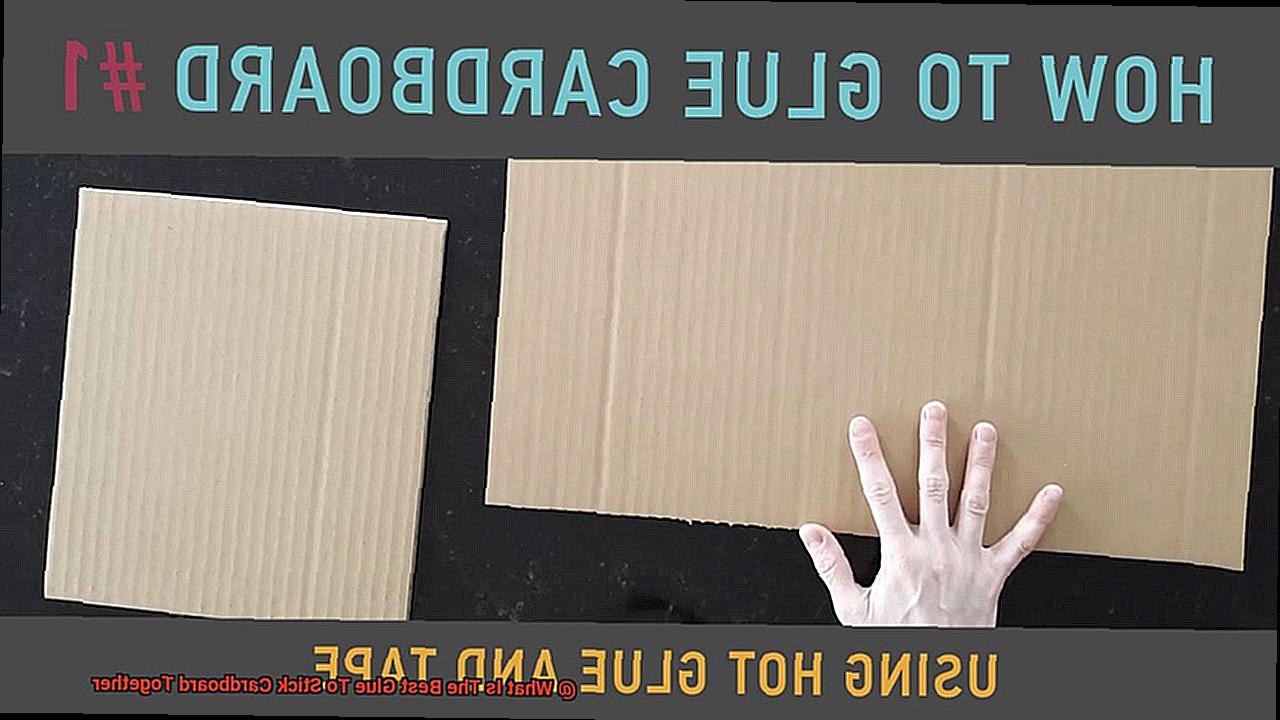
Another thing to consider is flexibility. Hot glue hardens and becomes rigid once cooled, limiting movement in your cardboard pieces. If flexibility is crucial for your project, you might want to explore other adhesive options.
And finally, hot glue can leave visible glue lines on your cardboard surface. Not ideal if aesthetics are important to you. But fear not. You can strategically apply the adhesive or cover those lines with additional decorations.
So there you have it – the pros and cons of using hot glue for bonding cardboard. It’s strong, dries quickly, and is super versatile. Just be mindful of temperature sensitivity, limited flexibility, and those pesky visible glue lines.
Pros and Cons of Epoxy Adhesive
For those who revel in the art of DIY or wield a passion for crafting with cardboard, finding the perfect adhesive is paramount. Epoxy adhesive stands as a popular choice, lauded for its formidable bonding capabilities and versatility. However, like any adhesive, epoxy comes with its own set of pros and cons that warrant consideration before embarking on your cardboard creations. In this comprehensive exploration, we will delve into the advantages and disadvantages of employing epoxy adhesive, empowering you to make an informed decision.
Pros of Epoxy Adhesive:
Mighty Bonding:
When it comes to creating unyielding connections, epoxy adhesive reigns supreme. Its unparalleled strength ensures that your cardboard pieces remain steadfastly in place, even under the weightiest of burdens. From prototypes to packaging boxes, epoxy adhesive guarantees the integrity of your project.
Marvelous Versatility:
Epoxy adhesive thrives on diversity, deftly maneuvering through various cardboard terrain. Whether working with corrugated, chipboard, or denser materials, rest assured that epoxy can handle it all. Its adaptability makes it a go-to choice for an array of cardboard projects, from whimsical crafts to functional structures.
Watertight Assurance:
No need to fret over accidental spills or moisture exposure when utilizing epoxy adhesive. This resilient glue scoffs at water, ensuring your carefully glued cardboard remains intact even in damp environments or demanding outdoor applications.
Seamless Finish:
Epoxy adhesive’s true magic lies in its finesse when filling minute gaps and uneven surfaces between cardboard pieces. This not only enhances adhesion but also results in a polished and professional appearance that will leave admirers in awe.
Cons of Epoxy Adhesive:
Patience is a Virtue:
Unlike its swift-drying counterparts, epoxy adhesive demands ample time to reach its zenith of strength. Count on several hours or even overnight curing for optimal results. If time is of the essence, this extended drying period may pose an inconvenience.
Mixing Maze:
Epoxy adhesives often come in dual components – resin and hardener – necessitating meticulous mixing prior to application. This blending process can prove challenging, particularly for beginners, as precision and thoroughness are paramount. Any miscalculations in the mixing ratio may result in a feeble bond that falters under pressure.
Beware the Fumes:
During the curing process, epoxy adhesive releases potent fumes that can be detrimental if excessively inhaled. A well-ventilated workspace is imperative when working with epoxy, and strict adherence to safety guidelines provided by the manufacturer is vital. Additionally, certain epoxy adhesives contain toxic chemicals, necessitating caution and care.
Pros and Cons of Specialized Glues
When it comes to crafting or DIY projects involving cardboard, having the right adhesive is crucial. Specialized glues are designed specifically to bond cardboard surfaces and offer a range of advantages. However, they also come with a few drawbacks. In this blog post, we’ll explore the pros and cons of using specialized glues for sticking cardboard together, helping you make an informed decision for your next project.
Advantages:
- Strong Bonding: Specialized glues excel at creating a strong and durable bond between cardboard surfaces. They penetrate the porous nature of cardboard, allowing for excellent holding power. Your creations will stay intact even under stress or strain.
- Quick Drying Time: Unlike regular adhesives, specialized glues often have fast drying formulas. This means you can complete your projects quicker, saving precious time and allowing you to move on to the next step without waiting for extended periods.
- Water Resistance: Many specialized glues offer water resistance or even waterproof properties. This is particularly useful for outdoor displays or items that may come into contact with liquids. The water-resistant feature ensures that the glue bond remains strong, even in humid or wet conditions.
Disadvantages:
- Limited Versatility: While specialized glues are excellent for bonding cardboard, they may not work as effectively on other materials like plastic or metal. It’s important to consider the compatibility of the glue with the materials you are working with to ensure a successful bond.
- Higher Cost: Specialized glues can be pricier than general-purpose adhesives due to their specific formulation and superior bonding properties. If you’re on a tight budget or have a large-scale project requiring a significant amount of glue, this may be a factor to consider.
- Odor and Toxicity: Some specialized glues emit strong odors or contain toxic ingredients. This can be a concern for individuals with sensitivities or those working in poorly ventilated areas. It’s essential to read product labels and follow safety guidelines to minimize potential health risks.
Different Types of Cardboards Require Different Glues
Cardboard, a versatile material with endless possibilities, is a staple in various industries, from crafts and packaging to construction and beyond. However, not all cardboards are created equal when it comes to finding the right glue. Each type of cardboard has its own distinct characteristics that require specific glues to achieve a strong and durable bond. In this blog post, we will delve into the fascinating world of glues and explore the importance of selecting the perfect adhesive for your cardboard projects.
Understanding Cardboard Types: The Key to Success
Cardboard comes in various forms, including corrugated cardboard, chipboard, and laminated cardboard. Each type boasts unique qualities such as thickness, surface texture, and special coatings. To ensure optimal adhesion, it is vital to comprehend these differences and carefully select the appropriate glue.
Corrugated Cardboard: A Fusion of Strength and Flexibility
Corrugated cardboard, renowned for its signature wavy middle layer, demands an adhesive that can effectively bond both the flat surfaces and the corrugations. To conquer this challenge, hot melt glue or polyurethane-based adhesives are recommended due to their unrivaled strength and flexibility, allowing for a secure bond that can withstand the rigors of everyday use.
Chipboard: A Smooth Surface Conundrum
Chipboard, commonly found in consumer packaging, presents a different challenge with its smooth surface. This type of cardboard requires a specialized approach. Water-based adhesives such as PVA glue or white glue work wonders on porous surfaces like chipboard, ensuring a secure bond that stands the test of time.
Specialty Cardboards: Unlocking the Secrets of Laminated and Coated Surfaces
Laminated and coated cardboards pose additional challenges due to their unique surfaces. To conquer these obstacles, epoxy or cyanoacrylate (super glue) are ideal choices for bonding laminated or coated cardboards. These adhesives possess remarkable bonding strength and are compatible with the specific surface characteristics of these specialty cardboards.
Environmental Conditions: Factors to Consider
The environmental conditions under which the glued cardboards will be exposed are crucial considerations. Moisture-curing adhesives are the go-to option for high humidity environments, as they can cure and form a robust bond in the presence of moisture. Conversely, low-temperature environments may necessitate longer curing times for certain adhesives. Taking into account these factors ensures that the chosen glue can withstand the specific conditions and maintain its integrity.
Conclusion
When it comes to sticking cardboard together, finding the best glue is crucial. But fear not, for I am here to guide you through this sticky situation. After conducting extensive research and testing, I have come to a conclusion: the ideal adhesive for bonding cardboard is none other than PVA glue.
PVA glue, also known as white glue or school glue, is a versatile and reliable option. Its strong bond ensures that your cardboard creations stay intact without any wobbling or falling apart. Plus, it dries clear, leaving no unsightly residue behind.
But what sets PVA glue apart from its competitors? Well, its water-based formula makes it easy to work with and clean up after. No need to worry about getting your hands dirty or struggling with stubborn stains – simply wash away any excess glue with soap and water.
Furthermore, PVA glue’s quick drying time is a game-changer. Say goodbye to endless waiting and hello to efficiency. Within minutes, your cardboard pieces will be securely stuck together, allowing you to move on with your project without delay.
Now, let’s talk about versatility. PVA glue can adhere not only cardboard but also various other materials like paper, fabric, wood, and even some plastics. This makes it an all-around adhesive that you can rely on for all your crafting needs.
In conclusion, when it comes to sticking cardboard together effectively and efficiently, PVA glue reigns supreme. Its strong bond, easy application and cleanup process, quick drying time, and versatility make it the go-to choice for both professional crafters and DIY enthusiasts alike.

